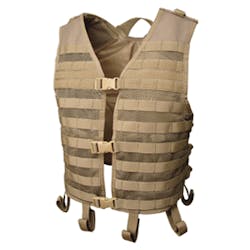Condor Tactical Gear Mesh Hydration Vest Review
About a year ago my youngest son joined an organization and became (almost immediately) a part of their search & rescue team. He needed a vest. He inherited mine and we reconfigured it for his intended use. I needed a replacement and borrowed an armored vest from a friend, configured it for my survival/emergency preparedness use and drove on. However, I knew that I eventually needed to procure a new vest and return the armored one. So, a couple months ago, thanks to WTG Tactical I became the proud owner of a Condor Mesh Hydration Vest. I didn't need the vest to carry armor; I just needed one that I could MOLLE mount gear pouches and a holster onto. This vest has worked perfectly.
My old vest, the one my son inherited, had both a zippered AND buckled front opening. You put it on like a jacket rather than pulling it over your head like most body armor. I always felt that the zipper and buckles were a bit redundant but redundancy is often good so I dismissed any questions or concerns from my mind. Then I saw folks who either cut off the buckles and only used the zipper, or folks who only buckled it and acted like the zipper didn't exist. For them, convenience took place over redundant security where it came to holding the vest closed/on. The Condor Mesh Hydration Vest (MHV) has only buckles; three of them, and they work just fine in holding the vest on. To reduce stress on the buckles and help them last even longer (although they'll probably work just fine long after I'm dead and gone), it's important you adjust your vest to fit properly.
The Condor MHV has six size adjustment straps: three on each side in the back. To adjust fit properly, put the vest on and buckle it closed; then pull the straps in turn until the vest fits snuggly but not uncomfortably. DO NOT cut off any excess strap, but instead roll them up if you don't want them dangling. Velcro wrap straps are provided with each one so you can secure them once their rolled up. Why don't we cut them? Think about the different seasons and what clothing (or armor) you might need to don this vest over. Make sure you have room to adjust the vest by leaving the straps full length.
The vest has padded and adjustable shoulder straps as well as a padded back with an emergency drag handle (which I most often use as a carry handle if I have to move the vest but aren't wearing it) attached securely at the top center of the back. The padded shoulders help the vest be more comfortable to wear even when it's loaded with gear and that weight is pulling into your shoulders. The fact that the shoulder straps are adjustable means you have some leeway in adjusting the bottom of the vest to sit where you'd like it to. The padded back provides a little stiffness, generally allowing some air flow between your back and the vest, helping to keep you cool and allowing sweat to evaporate. There is also a hydration pocket on the back but that's OUTSIDE the padding. Not only does this help keep the water cooler (because ambient temperature is usually cooler than body temperature), but it also let's the padding be directly against your back if you lean on anything to rest or get a stable position.
Around the waistline of the vest are six snapping belt loops that allow you to attach a gunbelt to the vest. In doing so, you create a single system that allows you to pull on and buckle the vest, buckle the belt, buckle leg straps and be on the move. That said, I'm not a fan of that arrangement so I consider the belt straps inconvenient and cut them off of my vest.
The vest is covered with MOLLE webbing, both front and rear, including on the outside of the hydration pocket (hydration bladder/tube not included) and farther up on both sides than most other vests I've seen. On the top four rows of MOLLE webbing in the front, there is velcro face so you can affix patches. For instance, I have a blood type patch affixed on the right side of mine, or you could put a name tape on there if you needed/wanted to. On the back, on the flap closure for the hydration pocket and the top row of MOLLE, there is more velcro face for patch attachment.
The owner of WTG Tactical helped me configure the vest before I even left the shop, so it was fully equipped and filled with my load-out before I ever left the store. The vest is adjustable from Medium to Extra-Large in fit, and is available in four colors: Olive Drab (the one I have), Black, Coyote Tan and ACU (Army Digital Camo).
On the WTG Tactical website this vest has a price of only $42.99. Any of you who have previously shopped equipment vests know what a good price that is. I have been more than satisfied with the function and performance of this vest so far. Check out more info about it either on the WTG Tactical website or on the Condor Tactical Gear website.
Happy Trails!
Web Links:
About The Author:
Lt. Frank Borelli (ret) is the Editor In Chief for Officer.com, and has 30 years of military and civilian law enforcement experience. An instructor since 1989 and having delivered training across the country, he stays active in police work, training, and writing. Frank has had five non-fiction and two fiction books published along with two research papers of specific interest to the law enforcement and/or military communities. All can be found / purchased on his Author Page on Amazon.com linked above. If you have any comments or questions, you can contact him via email to [email protected].
About the Author
Lt. Frank Borelli (ret), Editorial Director
Editorial Director
Lt. Frank Borelli is the Editorial Director for the Officer Media Group. Frank brings 20+ years of writing and editing experience in addition to 40 years of law enforcement operations, administration and training experience to the team.
Frank has had numerous books published which are available on Amazon.com, BarnesAndNoble.com, and other major retail outlets.
If you have any comments or questions, you can contact him via email at [email protected].

